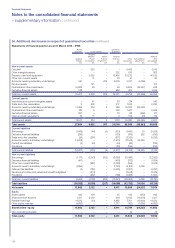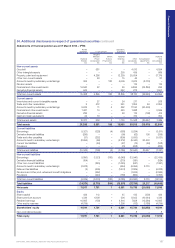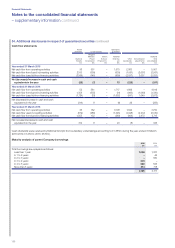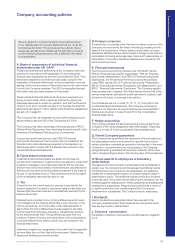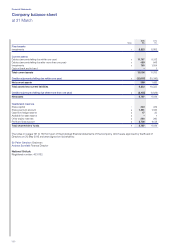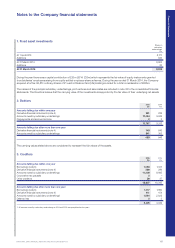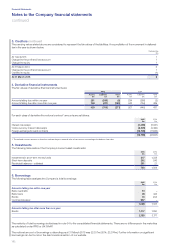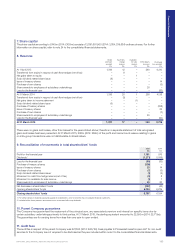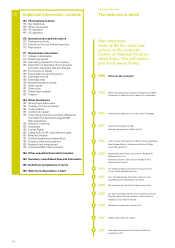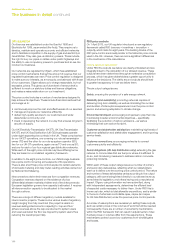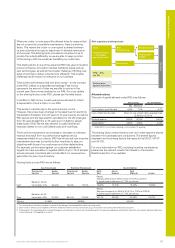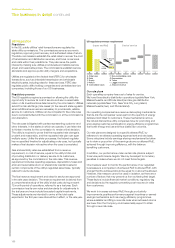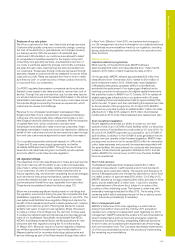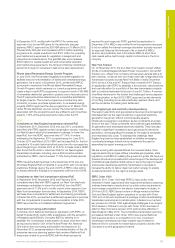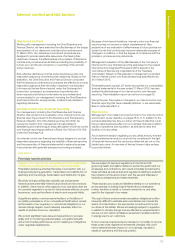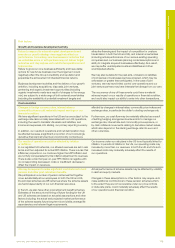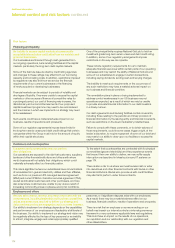National Grid 2015 Annual Report Download - page 168
Download and view the complete annual report
Please find page 168 of the 2015 National Grid annual report below. You can navigate through the pages in the report by either clicking on the pages listed below, or by using the keyword search tool below to find specific information within the annual report.
Additional Information
The business in detail continued
UK regulation
Our licences are established under the Gas Act 1986 and
Electricity Act 1989, as amended (the Acts). They require us to
develop, maintain and operate economic and efficient networks
and to facilitate competition in the supply of gas and electricity in
Great Britain. They also give us statutory powers. These include
theright to bury our pipes or cables under public highways and
theability to use compulsory powers to purchase land so we can
conduct our business.
Our networks are regulated by Ofgem, which has established
pricecontrol mechanisms that set the amount of revenue that our
regulated businesses can earn. Price control regulation is designed
to make sure our interests, as a monopoly, are balanced with those
of our customers. Ofgem allows us to charge reasonable, but not
excessive, prices. This gives us a future level of revenue that is
sufficient to meet our statutory duties and licence obligations,
andmakes a reasonable return on our investment.
The price control includes a number of mechanisms designed to
help achieve its objectives. These include financial incentives that
encourage us to:
• continuously improve the cost and effectiveness of our services;
• manage and operate our networks efficiently;
• deliver high-quality services to our customers and wider
stakeholder community; and
• invest in developing the network in a way that ensures long-term
security of supply.
Our UK Electricity Transmission (UK ET), UK Gas Transmission
(UKGT) and UK Gas Distribution (UK GD) businesses operate
under eight separate price controls in the UK. These comprise two
for our UK ET operations, one covering our role as transmission
owner (TO) and the other for our role as system operator (SO);
twofor our UK GT operations, again one as TO and one as SO;
andone for each of our four regional gas distribution networks.
While each of the eight price controls may have differing terms,
they are based on a consistent regulatory framework.
In addition to the eight price controls, our LNG storage business
has a price control covering some aspects of its operations.
Thereis also a tariff cap price control applied to certain elements
ofdomestic metering and daily meter reading activities carried out
by National Grid Metering.
Interconnectors derive their revenues from congestion revenues.
Congestion revenues depend on the existence of price
differentialsbetween markets at either end of the interconnector.
European legislation governs how capacity is allocated. It requires
all interconnection capacity to be allocated to the market
throughauctions.
There are a range of different regulatory models available for
interconnector projects. These involve various levels of regulatory
insight ranging from fully merchant (the project is reliant on
revenues selling interconnector capacity) to ‘cap and floor’
(whererevenues above the cap are returned to system users
andrevenues below the floor are topped by system users thus
reducing the overall project risk).
RIIO price controls
On 1 April 2013, our UK regulator introduced a new regulatory
framework called RIIO (revenue = incentives + innovation +
outputs), which lasts for eight years. The building blocks of the
RIIOprice control are broadly similar to the historical price controls
used in the UK. However, there are some significant differences
inthe mechanics of the calculations.
How is revenue calculated?
Under RIIO the outputs we deliver are clearly articulated and are
integrally linked to the calculation of our allowed revenue. These
outputs have been determined through an extensive consultation
process, which has given stakeholders a greater opportunity to
influence the decisions. The clarity around outputs should lead
togreater transparency in how we deliver them.
The six output categories are:
Safety: ensuring the provision of a safe energy network.
Reliability (and availability): promoting networks capable of
delivering long-term reliability, as well as minimising the number
and duration of interruptions experienced over the price control
period, and ensuring adaptation to climate change.
Environmental impact: encouraging companies to play their role
inachieving broader environmental objectives – specifically,
facilitating the reduction of carbon emissions – as well as
minimising their own carbon footprint.
Customer and stakeholder satisfaction: maintaining high levels of
customer satisfaction and stakeholder engagement, and improving
service levels.
Customer connections: encouraging networks to connect
customers quickly and efficiently.
Social obligations (UK Gas Distribution only): extending the gas
network to communities that are fuel poor where it is efficient to
doso, and introducing measures to address carbon monoxide
poisoning incidents.
Within each of these output categories are a number of primary
and secondary deliverables, reflecting what our stakeholders
wantus to deliver over the coming price control period. The nature
and number of these deliverables varies according to the output
category, with some being linked directly to our allowed revenue,
some linked to legislation, and others having only a reputational
impact. Ofgem, using information we have submitted, along
withindependent assessments, determines the efficient level
ofexpected costs necessary to deliver them. Under RIIO this is
known as totex, which is total allowable expenditure, and is similar
to the sum of what was controllable opex, capex (and repex
forUKGas Distribution) under the previous price control periods.
A number of assumptions are necessary in setting these outputs,
such as certain prices or the volumes of work that will be needed.
Consequently, there are a number of uncertainty mechanisms
within the RIIO framework that can result in adjustments to totex
ifactual prices or volumes differ from the assumptions. These
mechanisms protect us and our customers from windfall gains
andlosses.
166


